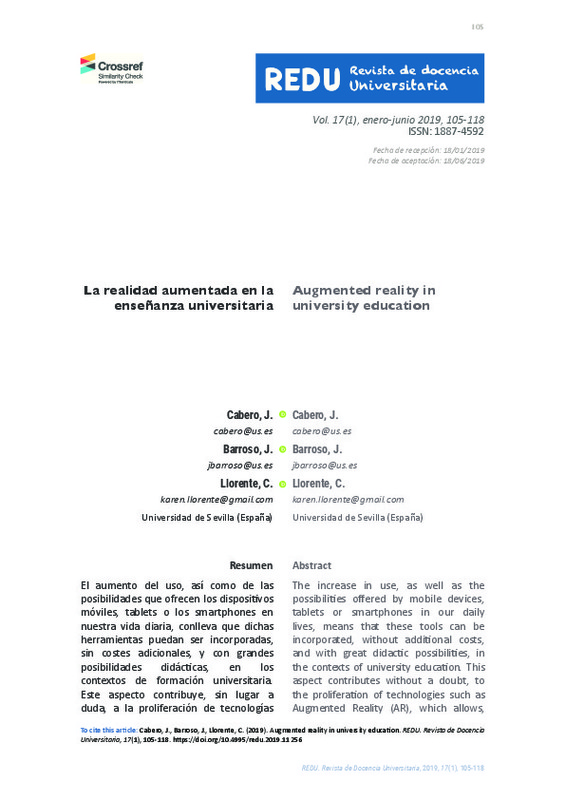|
Resumen:
|
[EN] The increase in use, as well as the possibilities offered by mobile devices, tablets or smartphones in our daily lives, means that these tools can be incorporated, without additional costs, and with great didactic ...[+]
[EN] The increase in use, as well as the possibilities offered by mobile devices, tablets or smartphones in our daily lives, means that these tools can be incorporated, without additional costs, and with great didactic possibilities, in the contexts of university education. This aspect contributes without a doubt, to the proliferation of technologies such as Augmented Reality (AR), which allows, using the aforementioned devices, to facilitate the combination of digital information and physical information in real time. In this article the problem of the conceptualization of the RA wont be presented, but its intended to offer a vision through the analysis of two of the variables that can be considered as limiting in the use of this technology in the university contexts: lack of research, and the few learning objects generated in RA format (all without forgetting the need to have theoretical frameworks to facilitate their educational incorporation). Likewise, its necessary to start from the fact that, if this technology is to be incorporated into university education, its essential that universities create and strengthen production centers that facilitate and/or help the teacher to produce them. And this, not because some objects can not be produced by the teachers themselves, but because complex objects require the management of complex programs, as well as the elaboration of resources of certain, much, difficulty.
[-]
[ES] El aumento del uso, así como de las posibilidades que ofrecen los dispositivos móviles, tablets o los smartphones en nuestra vida diaria, conlleva que dichas herramientas puedan ser incorporadas, sin costes adicionales, ...[+]
[ES] El aumento del uso, así como de las posibilidades que ofrecen los dispositivos móviles, tablets o los smartphones en nuestra vida diaria, conlleva que dichas herramientas puedan ser incorporadas, sin costes adicionales, y con grandes posibilidades didácticas, en los contextos de formación universitaria. Este aspecto contribuye, sin lugar a duda, a la proliferación de tecnologías como la Realidad Aumentada (RA), que permite, apoyándose en los dispositivos anteriormente comentados, facilitar la combinación de información digital e información física en tiempo real. En el presente artículo no se presentará la problemática de la conceptualización de la RA, sino que se pretende ofrecer una visión a través del análisis de dos de las variables que pueden ser consideradas como limitantes en el uso de ésta tecnología en los contextos universitarios: la falta de investigaciones, y los pocos objetos de aprendizaje generados en formato RA (todo ello sin olvidar la necesidad de contar con marcos teóricos para facilitar su incorporación educativa). Asimismo, es necesario partir de hecho de que, si se pretende que dicha tecnología se incorpore a la formación universitaria, es imprescincible que las Universidades creen y potencien centros de producción que faciliten y/o ayuden al docente para su producción. Y ello, no porque algunos objetos no puedan ser producidos por los propios docentes, sino porque objetos complejos requieren el manejo de programas complejos, así como de la elaboración de recursos de cierta, mucha, dificultad.
[-]
|








